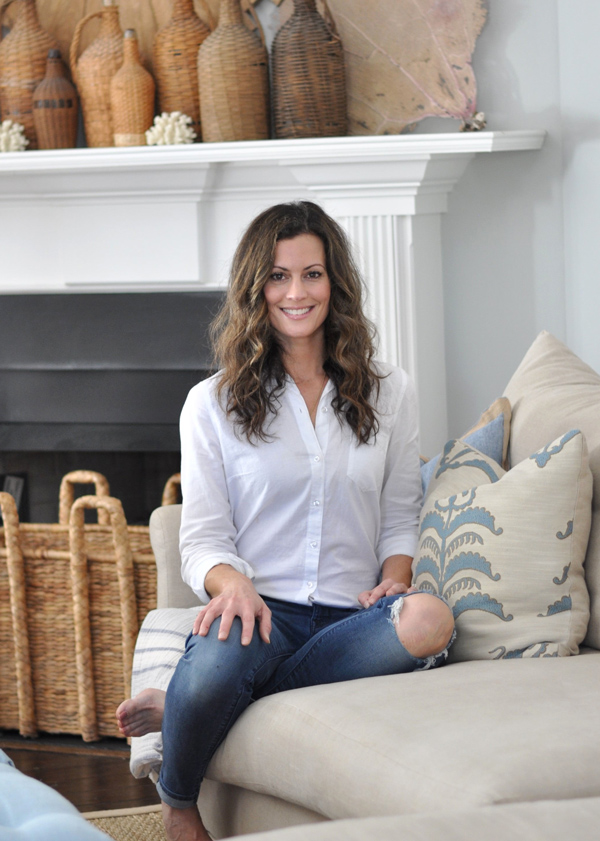diy: step-by-step guide to whitewashing furniture
Lately, I’ve gotten quite a few emails asking for help creating the whitewashed finish I wrote about last year, so I thought this would be the perfect opportunity to post a step-by-step guide for anyone interested in trying it! Whitewashing is a simple technique of watering down white paint and literally washing it over a piece of furniture with a paint brush, then wiping it back with a clean white cloth. It’s beautiful on its own, or you can take it one step further and drybrush overtop, which I’ll show you here. Here we go!
I find these pedestal end tables all over the place, and this one is actually one of a set of two. Here is the table after one coat of primer and one coat of Benjamin Moore Kendall Charcoal:

To make your whitewash, you’ll need a good faux latex glaze. I swear by this one by Sherwin Williams:

Mix four parts glaze to one part paint. I used 1/4 cup of glaze and about a tablespoon of Benjamin Moore White Dove. I added a little bit of water to thin it out-it will help extend your working time when you’re wiping it back (you won’t need to race to wipe it off as soon as you brush it on):

Once you’ve mixed your glaze, get to painting. I’ve had the best results painting in the direction of the grain of the wood. Just brush it on:

For a subtle look, you can wipe it back right away, or, you can let it sit for a minute and then, taking a clean white cloth, wipe it back in the direction of the wood grain, really making sure to get it in the grain. You can see in the picture below that the glaze mixture gets into the grain of the wood, highlighting it:

I like to work in sections, rather than painting the whole piece at once and then racing to wipe it all back. In this case, I did the entire table top, waited a minute or two, then wiped it all back. This is what the top looked like when I was done:

I like to err on the subtle side, so I use a light hand when mixing my glaze…it’s always easier to apply a second coat than to have to sand your finish down and start over. In this case, the top was a little lighter than I wanted, so I applied a second coat of glaze and then wiped it back again. Next, I moved on to the rest of the table, brushing my glaze mixture on and then wiping it off. I didn’t want the whole table to be uniform, so I used a heavy hand in some parts and used much less glaze in others. This is what the table looked like once I was done applying the glaze:

Once that was dry, I drybrushed white paint along the entire piece. I used a 2 inch Purdy XL. It’s angled and semi-stiff, which is perfect for drybrushing:

Make sure the brush is dry and dip ONLY the tip of the brush lightly into your paint, then dab it onto a cloth until there’s almost no paint on it (excuse my ugly brush – mine really take a beating):

Use light, feathery strokes, going with the grain of the wood. The idea is to highlight the grain and any imperfections, creating a distressed, aged finish:

One tip that makes a HUGE difference: flicking your brush back and forth from one corner or edge to the other creates a chalky, beautiful highlight:

See what a difference it makes on the legs? Such an easy way to create a beautiful highlight:

Again, I drybrushed randomly, to avoid making it look perfect. Once it’s dry, I suggest using a wipe on polyurethane in a clear satin finish like this one:

Here is the table once I finished:






Happy painting!
Posted in DIY, paint technique

Hello and welcome to Bungalow Blue Interiors!
I'm Kelly, interior designer, stylist, hostess with the mostest and editor of my blog, where I share pics of my work, my own home, décor projects, entertaining hacks, where to find the best decorating deals and all the beautiful things that are currently inspiring me!

Gorgeous! Thanks for the tutorial – you are so talented!
What a great tutorial! Looks so good Kelly!
Melissa
Thanks, Kate and Melissa! 🙂
I'm so happy you re-posted this DIY!! We are looking forward to redoing our kitchen table using this technique…thanks Kelly:) I can't wait to share our finish project!
It looks amazing. This is a really nice tutorial you made for us. It looks like an antique piece right now. I should try this too. Thanks for the tips.
Just the other day my friend was asking me if i know anything about what you did here. I will redirect him to this place so he can learn.
this is just gorgeous!! thank you so much for the tutorial!
Thanks for the tutorial big help!!
Thanks for the info, my husband and I are building a boat to put towels on in our kids bathroom. We weren't for sure on exactly how to do so we will try it out.
I have a question – did you do anything to the wood prior to priming and painting it? I have some hand-me-down pieces that I'd like to update and I wanted to know if I needed to do anything to the furniture before (i.e. sand it first) priming and/or painting. Thanks!
Meghan – I did a quick sanding with a 200 grit paper just to rough it up enough for the primer to stick. If there's no finish on the furniture, you should be good to just go ahead and prime but I'd still rough it up a little. Hope this helps!
Meghan – I did a quick sanding with a 200 grit paper just to rough it up enough for the primer to stick. If there's no finish on the furniture, you should be good to just go ahead and prime but I'd still rough it up a little. Hope this helps!
Quick question on technique hopefully you can clarify…
1) can you use a sprayer to get the primer and grey coat down first before applying the glaze or will that affect the look of the project?
Is a brush better? Looking to save time but don't want to lose the effect either.
2) what do mean by light hand an heavy hand when applying the glaze? When you said the first coat of glaze made the table "…too light" you went back and added more glaze to darken the grey. Seems backwards to me. So more glaze means darker look?
Sorry for the newbie questions!
Thanks!
Harte – I've never used a sprayer for pieces that I'm going to whitewash and/or dry brush, but I don't see why you couldn't. The "light hand" comment was in reference to mixing the glaze, not applying it, in that I start out with a lighter glaze mixture and then if it goes on too light or not white enough, I add a second coat (or, you could always add more white paint to your mixture). I was actually not darkening the grey at all, but rather trying to lighten it, as you can tell from the picture with just the gray paint versus the finished piece with the whitewash and dry brushing. I used a "heavy hand" with the glaze on some parts for more white and less on others to avoid a uniform look. Hope this helps, good luck!
Thanks Kelly…that makes more sense on your technique!
I appreciate the timely response!
Kelly…
FYI…I just picked up a qt of that Sherman Williams clear glaze to use in my project (to Duplicate the same effect of your grey table).
The SW employee told me they have discontinued this product. May be a local thing (we're in Los Angeles ), but if true you may want to stock up before it's all gone.
Harte
Harte – thank so much for the head's up! I still have a couple quarts in the garage, but what a bummer! Home Depot has a good one by Behr, if you're ever in a bind and can't find it at Sherwin Williams. Best of luck!
Kelly,
I love the table.
Thanks for the great tutorial.
Was the table originally stained wood? If so, did you need to sand it before you primed it or did you just prime right over the stain?
Thanks!
Cindy
Hi, Cindy, thank you so much! The table originally had a yellowed, oak finish; I sanded it just enough to get the poly off of it but I didn't strip it since I was going to paint it. I scuffed it up enough for the primer to stick and then painted on top of it. Hope this helps! Happy weekend!
This is the exact look I want except I want the base to look white with just a hint of gray throughout. Do you think I could get that look by reversing the colors – painting it white and gray washing it?
Sherri – you most definitely could reverse the paint colors! I would probably go a little lighter than the charcoal gray I chose, just because it would be too much contrast with the white UNLESS that's what you're going for! Good luck 🙂